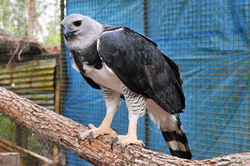| Harpy eagle |
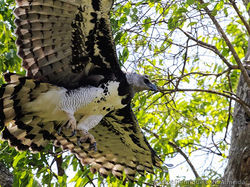 |
| Scientific Classification |
|
|
| Binomial Name |
harpia harpyja |
|
|
| Perched harpy eagle |
The Harpy eagle is a species of eagle known by the scientific name harpia hapyja. It's scientific and common name derives from the Harpies of Greek mythology, which were flying monsters with sharp claws.[2] They are located all over Central and South America and are considered the "kings of the canopy"[3], as well as the national bird of Panama.[2] With the role as one of the top predators in the rainforest, they are very important in controlling many species populations.[4] They are perhaps best known for being one of the most powerful, and definitely heaviest, eagles in the world. Despite their power, they are endangered with humans being their biggest threat. They are hunted for their tail feathers to create ceremonial head dresses and the deforestation of silk-cotton trees reduce the number of their nesting places. Because of this, harpy eagles are rarely sighted in the wilderness.[5]
Much like the case for most eagles, the female is significantly larger than their mate and eyesight is vital when hunting. Harpy juveniles must be taken care for carefully and for an extended period of time, only allowing the parents to breed once every two or three years. Harpy eagles are distinguished especially by the feathers that fan around the bird's head when frightened and their beautifully striped tail feathers. Their talons are known for their grizzly-bear claw length and the incredible power they can deliver.[6][7]
These birds are majestic and impressive, displaying God's glory to all who can see.
Body Design
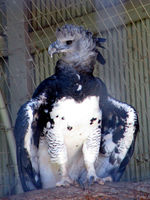
Feathers of the harpy eagle are mostly shades of gray and white.
Harpy Eagles are known to be among the world's largest eagles with a body length between 36-40 inches long.[8] It is the largest raptor in the Amazon rainforest. Like most birds of prey, females are larger than males. Females are between 13 to 20 pounds while males weigh in to only 9 to 11 pounds. Dark gray feathers with a white underside cover the bird and the body is speckled with black and brown. Black plumage across it's neck separate the head from the body and a crown of small, light gray feathers wraps around it's head. When threatened, they fan into a striking arc.[6] Young harpies are whitish-gray all over with dark stripes on the tail feathers and a lightly-colored 'disc'. The juveniles darken as they age, acquiring adult coloring at four years old.[9]
It's wingspan is fairly short at 78 inches.[10] This makes maneuvering through forests easier. The underside tips are striped with black and white feathers. The foot of a harpy eagle has four toes - three pointed forward and one pointing back. Their legs can be thick as a human wrist and their talons can reach to an incredible 5 inches long - the equivalent of the claws of a grizzly bear![10] They can exert a pressure of 530 pounds per square inch and can lift over three-quarters of it's own body weight. Their large black beak hooks sharply, designed for their carnivorous diet. Like other eagles, harpia harpyja have extremely well developed eyesight and can even spot a rabbit two miles away due to their ability to dilate and constrict their pupils; this allows them to focus near and far.[11]
Life Cycle
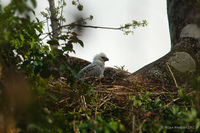
A young harpy eagle in it's nest
Harpy eagles are monogamous (mated for life) and do not have a courtship display before mating. The couple build the nest together, made of sticks lined with leaves, seedpods, and animal fur; the nest will usually measure about 4 feet thick and 5 feet across, which would be large enough for someone to lay in.[6] While building the nest, the pair occasionally rub their beaks together. The exact science of this is not explained but it seems to help maintain their bond.[7] The female lays two dull white eggs, incubating them for about 56 days.[9] During this period, the male will bring food for it's mate every few days. While the female eats his catch, he will switch off with her and keep the egg warm until she is finished. Once one baby bird breaks through the shell, the other egg is ignored and does not hatch.[8] Harpy eagle chicks are hatched semi-altricial meaning they are born with completely white coat of downy feathers and eyes open but they are incapable of flying and must be fed by their parents.[7]
The hatchling fledges after four and half to six months, but remains close to the nest for another year. The parents will feed it for up to ten months and attack intruders that come close to their chick. Because of this slow process, the adults do not breed often; usually only once every two or three years after the chick is independent.[2] Once the young eagle matures, regardless of gender, it will have the ability to reproduce at four or five years old. Breeding season takes place between April or May until December or January. Harpy eagles have a lifespan recorded to be about 25-35 years in the wild.[7]
Ecology
The harpy eagle is widely dispersed throughout Central and South America, from southern Mexico to Paraguay, southern Brazil and north-eastern Argentina. It is hardly ever spotted in the wild however mostly due to the fact it's edging to extinction, particularly in parts of Central America.[12] It was previously known to be spread throughout the wet lowlands and mountain slopes on the on the Caribbean and southern Pacific slopes. Although currently rare, they were formerly commonly seen in the foothills of the entire Caribbean and Pacific slope, areas of heavy forest in Panama, in the humid forest of the Oriente, and from sea level to 1640 feet above on the Atlantic slope from Veracruz and eastern Oaxaca.[4]
These eagles live in the humid lowlands of tropical and subtropical forests. They are found in the mid to upper canopies in rain forests where their preferred prey is found.[7] They are very solitary animals with the exception of mating - the partner they stay with for the rest of their lives. Harpy eagles seem to prefer silk-cotton trees for nesting. Nests have been found less than two miles apart from each other in Panama and Guyana.[13] Their nests, called aeries, are built high off the ground on cliffs or trees at 130 feet or above. They take place as the top of the food chain beside jaguars and anacondas in the Amazon rainforest of South America.[14] They require over eighteen and a half square miles for hunting and will drive out any competition.[7]
Hunting And Communication
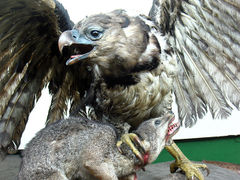
The harpy eagle and it's kill
Harpies hunt during the day and can reach a speed of 50 miles per hour. They are solitary hunters, using their keen eyesight to detect prey. They will patiently perch for up to 23 hours scanning the trees and ground for food. They have a carnivorous and very diverse diet consisting of sloths, monkeys, lizards, birds, many types of rodents, snakes, and even small deer.[15] With their short, broad wings, harpies can fly up nearly vertically so it can attack it's prey from above or below. Their eyes are specially designed for hunting; they can spot an animal only an inch long moving from 220 yards away.[6]
If the eagle decides on a prey on the ground, it'll tuck in his wings and dive. Just before contact, it spreads it's wings to catch the air and slow it's descent before snapping its talons out for the kill.[16] For arboreal animals (ones that live in trees) which seems to be it's preference, the predator will swoop in, grab hold, and glide back to their nest. Their sharp talons, can exert over five hundred pounds of pressure per square inch on it's victim, crushing it's bones and organs, thereby killing it instantly. The females, because of their larger size, tend to carry the larger prey versus the males who take more quantities of smaller portions.[7]
The harpy eagle communicates in a series of plaintive mix of chirping and screeching described as 'wheeeeeeee' or 'wheeeoooooo'. When begging for food, the young that are still taken care of by their parents will shrug and open their wings whilst calling 'whee-e-e-e' repeatedly.[12] During incubation, the female will give a shorter call of 'wheeeeeeee', repeated 9-12 times. When approaching the nest during the incubation period, the male will notify the female.[7]
Video
In a rainforest in Panama, a few men visit the nest of a harpy eagle as well as share some facts.
References
- ↑ Harpia Harpyja Taxonavigation Wikispecies. Web. Last modified January 1, 2014. Author unknown.
- ↑ 2.0 2.1 2.2 Harpy Eagle: Reproduction WEBS. Web. Published 2010. Author unknown.
- ↑ Roge. The Harpy Eagle - King of the Canopy Children's Tropical Forests. Web. Accessed January 11, 2015.
- ↑ 4.0 4.1 The Peregrine Fund Global Raptors. Web. Last updated December 11, 2011. Author unknown.
- ↑ Birds: Harpy Eagles AZA. Web. Accessed January 11, 2015. Author unknown.
- ↑ 6.0 6.1 6.2 6.3 Birds|Harpy Eagle San Diego Zoo Global. Web. Accessed December 6, 2014. Author unknown.
- ↑ 7.0 7.1 7.2 7.3 7.4 7.5 7.6 7.7 Shaner, Kyle. University of Michigan - Harpia Harpyja ADW. Web. Last updated February 13, 2011.
- ↑ 8.0 8.1 Harpy Eagle Fact Sheet PBS. Web. Published November 7, 2011. Author unknown.
- ↑ 9.0 9.1 Dudfield, Andy. Harpy Eagle Fact File Wildscreen. Web. Date of publication. July 2012.
- ↑ 10.0 10.1 Harpy Eagle CFC. Web. Accessed December 6, 2014. Author unknown.
- ↑ Eagle Eyes ANCA. Web. Accessed December 14, 2014. Author unknown.
- ↑ 12.0 12.1 Harpy Eagle Fact File Wildscreen Arkive. Web. Published July 2012. Author unknown.
- ↑ Llyod, H. and Miller, B. Harpy Eagle Harpia Harpyja BirdLife International. Web. Published October 12, 2014.
- ↑ Tambopata Wildlife - Harpy Eagle Facts Yahoo! Web. Published April 19, 2012. Author unknown.
- ↑ Schulenberg, T.S. Life History - Harpia Harpyja Cornell. Web. Last updated 2009.
- ↑ W, Miles. Wildlife of the Rainforest PBWorks. Web. Last updated 2011.

